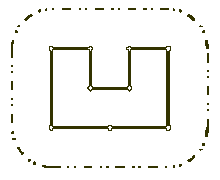题目链接:http://acm.hdu.edu.cn/showproblem.php?pid=1348
Wall
Time Limit: 2000/1000 MS (Java/Others) Memory Limit: 65536/32768 K (Java/Others)
Total Submission(s): 3386 Accepted Submission(s): 968
Problem Description
Once upon a time there was a greedy King who ordered his chief Architect to build a wall around the King‘s castle. The King was so greedy, that he would not listen to his Architect‘s proposals to build a beautiful brick wall with a perfect shape and nice tall
towers. Instead, he ordered to build the wall around the whole castle using the least amount of stone and labor, but demanded that the wall should not come closer to the castle than a certain distance. If the King finds that the Architect has used more resources
to build the wall than it was absolutely necessary to satisfy those requirements, then the Architect will loose his head. Moreover, he demanded Architect to introduce at once a plan of the wall listing the exact amount of resources that are needed to build
the wall.
Your task is to help poor Architect to save his head, by writing a program that will find the minimum possible length of the wall that he could build around the castle to satisfy King‘s requirements.

The task is somewhat simplified by the fact, that the King‘s castle has a polygonal shape and is situated on a flat ground. The Architect has already established a Cartesian coordinate system and has precisely measured the coordinates of all castle‘s vertices
in feet.
Input
The first line of the input file contains two integer numbers N and L separated by a space. N (3 <= N <= 1000) is the number of vertices in the King‘s castle, and L (1 <= L <= 1000) is the minimal number of feet that King allows for the wall to come close to
the castle.
Next N lines describe coordinates of castle‘s vertices in a clockwise order. Each line contains two integer numbers Xi and Yi separated by a space (-10000 <= Xi, Yi <= 10000) that represent the coordinates of ith vertex. All vertices are different and the sides
of the castle do not intersect anywhere except for vertices.
Output
Write to the output file the single number that represents the minimal possible length of the wall in feet that could be built around the castle to satisfy King‘s requirements. You must present the integer number of feet to the King, because the floating numbers
are not invented yet. However, you must round the result in such a way, that it is accurate to 8 inches (1 foot is equal to 12 inches), since the King will not tolerate larger error in the estimates.
This problem contains multiple test cases!
The first line of a multiple input is an integer N, then a blank line followed by N input blocks. Each input block is in the format indicated in the problem description. There is a blank line between input blocks.
The output format consists of N output blocks. There is a blank line between output blocks.
Sample Input
1
9 100
200 400
300 400
300 300
400 300
400 400
500 400
500 200
350 200
200 200
Sample Output
Source
标准的凸包果题!
题意:求得n个点的凸包后,然后求与凸包相距为L的外圈的周长。
思路:绘图后可知,最后所求的周长就是等于凸包周长+半径为L的圆的周长。
附图片一张(转载):

代码例如以下:
//#pragma warning (disable:4786)
#include <cstdio>
#include <cmath>
#include <cstring>
#include <string>
#include <cstdlib>
#include <climits>
#include <ctype.h>
#include <queue>
#include <stack>
#include <vector>
#include <utility>
#include <deque>
#include <set>
#include <map>
#include <iostream>
#include <algorithm>
using namespace std;
const double eps = 1e-9;
//const double pi = atan(1.0)*4;
const double pi = 3.1415926535897932384626;
#define INF 1e18
//typedef long long LL;
//typedef __int64 LL;
const int MAXN = 1017;
struct point
{
int x,y;
}e[MAXN],res[MAXN];//坐标点集,位于凸包上的点
bool cmp(point a,point b)//排序方法
{
if(a.x == b.x)
return a.y < b.y;
return a.x < b.x;
}
int cross(point a,point b,point c)//叉积(向量积)
{
return (a.x-c.x)*(b.y-c.y)-(b.x-c.x)*(a.y-c.y);
}
double lenght(point a,point b)//距离
{
return sqrt(1.0*(a.x-b.x)*(a.x-b.x)+(a.y-b.y)*(a.y-b.y));
}
int convex(int n)//求凸包上的点
{
sort(e,e+n,cmp);
int m=0, i, k;
//求得下凸包,逆时针
//已知凸包点m个,假设新增加点为i,则向量(m-2,i)必然要在(m-2,m-1)的逆时针方向才符合凸包的性质
//若不成立,则m-1点不在凸包上。
for(i = 0; i < n; i++)
{
while(m>1 && cross(res[m-1],e[i],res[m-2])<=0)
m--;
res[m++]=e[i];
}
k = m;
//求得上凸包
for(i = n-2; i >= 0; i--)
{
while(m>k && cross(res[m-1],e[i],res[m-2])<=0)
m--;
res[m++]=e[i];
}
if(n > 1)//起始点反复。
m--;
return m;
}
int main()
{
int t, n, m, L;
scanf("%d",&t);
while(t--)
{
scanf("%d%d",&n,&L);
for(int i = 0; i < n; i++)
scanf("%d%d",&e[i].x,&e[i].y);
m = convex(n);
double ans = 0;
for(int i = 1; i < m; i++)//求凸包的周长
ans+=lenght(res[i],res[i-1]);
ans+=lenght(res[m-1],res[0]);//首尾相接
ans+=2*pi*L;//加上以L为半径的圆的周长
printf("%.0lf\n",ans);
if(t != 0)
printf("\n");
}
return 0;
}
